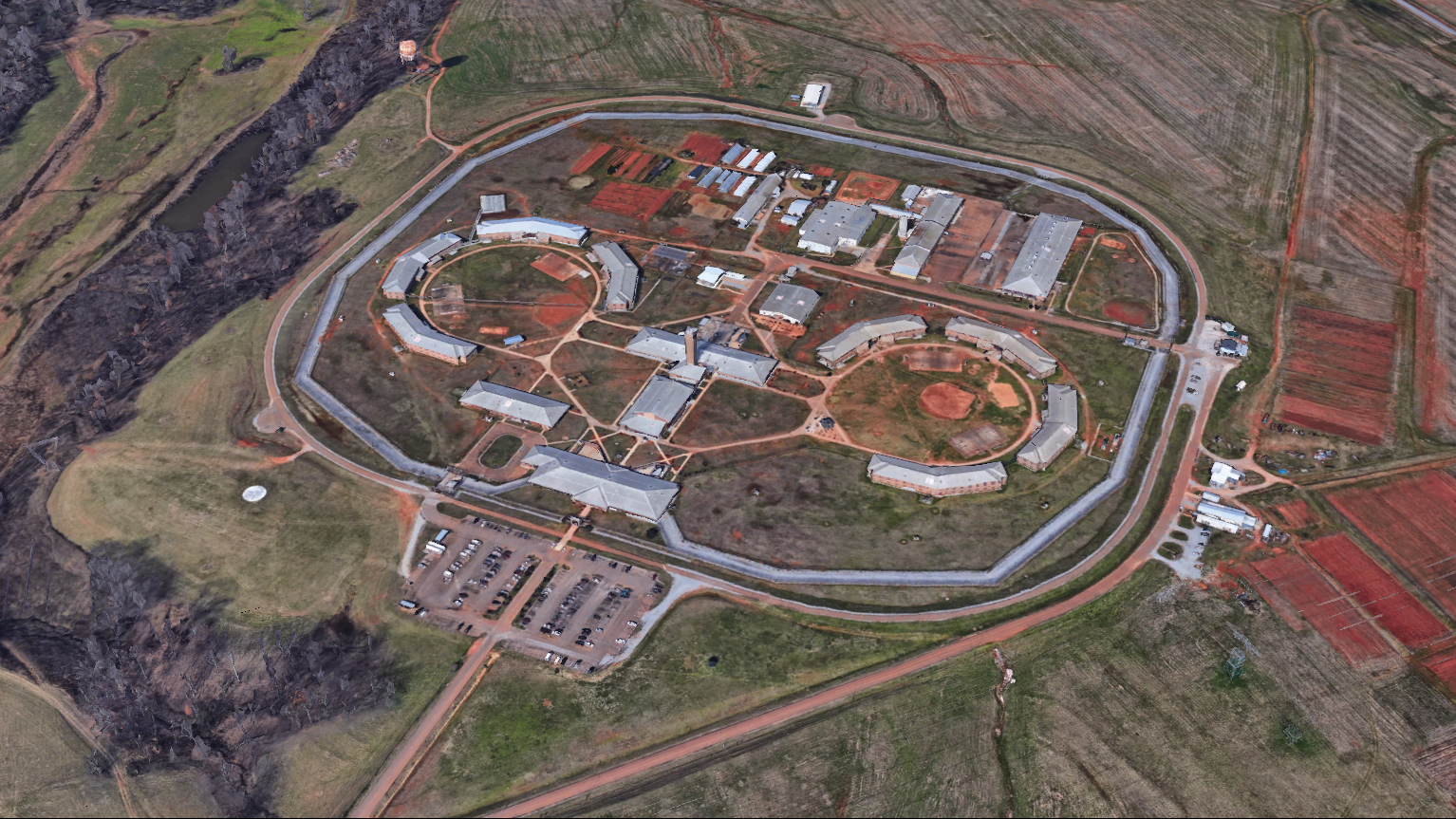A man serving a sentence at Limestone Correctional Facility died after being assaulted by another incarcerated man, and two days later, there was a separate stabbing incident between men in the prison that resulted in injuries, the Alabama Department of Corrections confirmed to APR on Monday.
The death, separate attack, and other recent homicides and suicides underscore longstanding problems in Alabama’s understaffed, overpopulated prisons.
Jody Potts, 58, died May 6 from injuries sustained during an apparent assault, ADOC spokesperson Kristi Simpson said in a message to APR. The exact cause of death awaits an autopsy, she said.
“Violence within ADOC facilities is not tolerated, and the fatal actions taken against Potts by another inmate are being thoroughly investigated by the Department’s Law Enforcement Services Division,” Simpson said.
In the separate stabbing incident on May 8 between incarcerated men some were injured but not critically, Simpson said.
“This is the only recent incident at Limestone Correctional Facility in which an inmate was stabbed during an inmate-on-inmate altercation,” Simpson said.
Two days before Potts was killed, Ian Rettig was stabbed to death at Fountain Correctional Facility, the day before he was to be released, which was to be his 24th birthday.
The U.S. Department of Justice in an April report noted that Alabama prisons have the fifth-highest average annual rate of mortality per 100,000 incarcerated persons from 2001 to 2018. Alabama also tied with California and Mississippi for the fifth-highest average annual homicide rate during those years.
Deaths in Alabama prisons skyrocketed between 2008 and 2018. The mortality rate in Alabama prisons during those years increased more than any other prison system in the country. DOJ reports and the department’s lawsuit against the state and ADOC details long-seated problems of understaffing and overpopulated prisons, rampant drug use, corruption and violence at the hands of guards.
Suicides inside Alabama prisons also continue to mount. Jerry Purnell, 67, was found unresponsive in his cell at St. Clair Correctional Facility on May 7. Attempts to save his life failed, and his death is being investigated as a possible suicide, ADOC said in a statement, although the department didn’t indicate why ADOC believes it may have been a suicide.
Tommy McConathy, 31, died at the Bullock Correctional Facility on March 2, according to an April court filing in an ongoing 2014 lawsuit. McConathy’s death was also investigated as a suicide. The Alabama Disability Advocacy Program and the Southern Poverty Law Center brought the lawsuit in the Braggs v. Dunn case over ADOC’s inadequate mental health care for incarcerated people.
McConathy was the 10th person to die by suicide in Alabama prisons after U.S. District Judge Myron Thompson filed an opinion in May 2019, which made permanent previously agreed to interim suicide-prevention measures. McConathy was the third person to die by suicide in so many months, according to the April court filing.
McConathy had been diagnosed with Major Depressive Disorder with psychotic features and was showing signs of paranoia and anxiety in the months leading up to his suicide, according to court records.
“McConathy repeatedly reported that he had been physically and sexually assaulted by other prisoners, both at a previous prison and in the Bullock Residential Treatment Unit,” the court filing states. “Despite his deep fears about being assaulted again, he was repeatedly returned to the RTU where some of the assaults had taken place, and he was placed in a cell with another prisoner in the SU despite pleas to be placed alone in a cell for his safety.”
Almost three months before he died, a mental health worker noted that McConathy was experiencing suicidal thoughts and auditory hallucinations daily, and had been placed on suicide watch numerous times due to his “desire to die” and his need for safety in a single cell, the filing reads.
For the next four weeks, McConathy continued to ask to be placed in a single cell, and was taken to an outside hospital for treatment on Jan. 13, and returned to a more protective stabilization unit at Bullock prison four weeks later.
On the day before his suicide, a nurse’s progress note indicates McConathy was still paranoid, hearing voices and fearful for his safety. Even so, the nurse’s note states that the plan was to discharge him from the stabilization unit and transfer him to the less protective residential treatment unit at Donaldson Correctional Facility.
The next day, he died by suicide, according to the court filing.
Gary Cambell, 43, also died by suicide in the segregation unit at Limestone Correctional Facility on Nov. 27, according to the court filing. Jail staff in January noted Campbell was becoming increasingly paranoid and was sending “bizarre letters to the warden” and two referrals to place him on the mental health caseload, which would have provided him with more protective measures, were made, yet he was never afforded those protections.
“After both referrals, staff tried to meet with him, but he refused to come out of his cell. No further efforts to provide mental health care to him are documented in his record,” the plaintiffs’ attorneys wrote to the court.
Travis Jackson, 43, also died by suicide in a segregation cell at Fountain Correctional Facility on Feb. 29, according to the court filing. Jackson was also never placed on the mental health caseload despite self-injury acts, numerous reports of suicidal thoughts and having recently set his cell on fire, the filing states.
Gov. Kay Ivey and ADOC commissioner Jeff Dunn continue to back a plan to build three new prisons, and say the buildings would improve safety and make more room for rehabilitative services, statements that opponents to the new construction say fall far short of addressing the problem. The prison plan has been estimated to cost more than $3 billion, and the state wouldn’t own the prisons at the end of the 30-year leases.
Ivey’s plan calls for two new prisons to be built by the private prison company CoreCivic, then leased back to the state for ADOC to operate. Discussions are ongoing for a third prison to be built by a group called Alabama Prison Transformation Partners, made up of Star America, BL Harbert International, Butler-Cohen, Arrington Watkins Architects and Johnson Controls Inc.
Barclays Capital and another underwriter in April pulled out of the CoreCivic project after mounting criticism. Another underwriter, Stifel Financial Corp., indicated that the company has also pulled out of the CoreCivic deal.
Some Alabama lawmakers have suggested it would be less costly for the state to use bonds to build new prisons, and disregard plans to lease them from private companies.
With the continuing implosion of CoreCivic financing, it’s uncertain what may come of Ivey’s plan, and with just one day left in this Legislative session, on Monday, the window for lawmakers to introduce and debate a bill for the state to build its own prisons is very narrow.
Ivey’s chief of staff, former Congressman Jo Bonner, on Saturday told the Mid-Alabama Republican Club that Ivey hoped to have an announcement on the prison “within days,” or within weeks. Despite insistence that new prisons will help alleviate Alabama’s prison crisis, the U.S. Department of Justice warned new buildings alone won’t solve the long-standing problems.
The DOJ in December sued the state of Alabama and the Alabama Department of Corrections alleging violations of inmates’ constitutional rights to protection from prisoner-on-prisoner violence, sexual abuse and excessive force by prison guards.
The DOJ in a December 2019 report noted Alabama’s aging prison infrastructure presented problems but warned against focusing solely on new buildings.
“While new facilities might cure some of these physical plant issues, it is important to note that new facilities alone will not resolve the contributing factors to the overall unconstitutional condition of ADOC prisons, such as understaffing, culture, management deficiencies, corruption, policies, training, non-existent investigations, violence, illicit drugs, and sexual abuse,” the federal government wrote in the report. “And new facilities would quickly fall into a state of disrepair if prisoners are unsupervised and largely left to their own devises, as is currently the case.”






















































